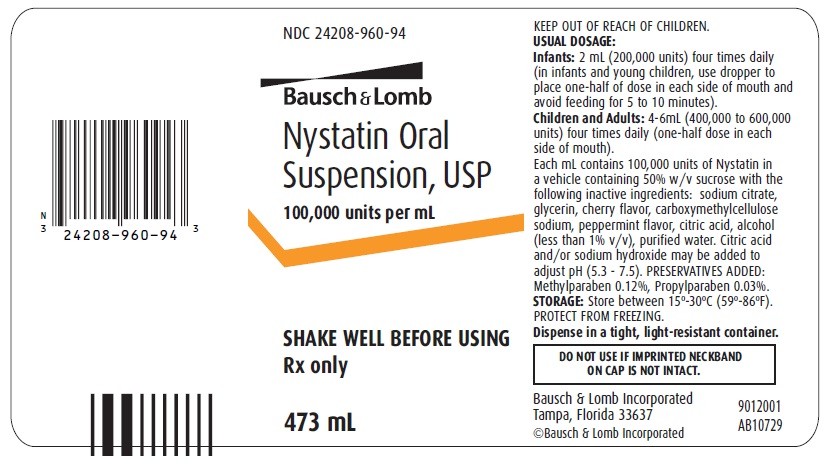Nystatin
Nystatin OralSuspension, USP
FULL PRESCRIBING INFORMATION: CONTENTS*
- NYSTATIN DESCRIPTION:
- CLINICAL PHARMACOLOGY:
- NYSTATIN INDICATIONS AND USAGE:
- NYSTATIN CONTRAINDICATIONS:
- PRECAUTIONS:
- NYSTATIN ADVERSE REACTIONS:
- NYSTATIN DOSAGE AND ADMINISTRATION:
- HOW SUPPLIED:
- Storage:
- Principal Display Panel
FULL PRESCRIBING INFORMATION
100,000 units per mL
Rx only
DESCRIPTION:
Nystatin is an antimycotic polyene antibiotic obtained from Streptomyces noursei. Its structural formula is:

C47H75NO17 Mol. Wt. 926.13
Each mL contains 100,000 units of Nystatin in a vehicle containing 50% w/v sucrose with the following inactive ingredients: sodium citrate, glycerin, cherry flavor, carboxymethylcellulose sodium, peppermint flavor, citric acid, alcohol (less than 1% v/v), purified water. Citric acid and/or sodium hydroxide may be added to adjust pH (5.3 - 7.5).
PRESERVATIVES ADDED: Methylparaben 0.12%, Propylparaben 0.03%.
CLINICAL PHARMACOLOGY:
Pharmacokinetics
Gastrointestinal absorption of nystatin is insignificant . Most orally administered nystatin is passed unchanged in the stool. In patients with renal insufficiency receiving oral therapy with conventional dosage forms, significant plasma concentrations of nystatin may occasionally occur.
Microbiology
Nystatin is both fungistatic and fungicidal in vitro against a wide variety of yeasts and yeast-like fungi. Candida albicans demonstrates no significant resistance to nystatin in vitro on repeated subculture in increasing levels of nystatin; other Candida species become quite resistant. Generally, resistance does not develop in vivo.
Nystatin acts by binding to sterols in the cell membrane of susceptible Candida species with a resultant change in membrane permeability allowing leakage of intracellular components. Nystatin exhibits no appreciable activity against bacteria, protozoa, or viruses.
INDICATIONS AND USAGE:
Nystatin Oral Suspension is indicated for the treatment of candidiasis in the oral cavity.
CONTRAINDICATIONS:
The preparation is contraindicated in patients with a history of hypersensitivity to any of its components.
PRECAUTIONS:
General
This medication is not to be used for the treatment of systemic mycoses. Discontinue treatment if sensitization or irritation is reported during use.
Carcinogenesis, Mutagenesis, Impairment of Fertility:
No long-term animal studies have been performed to evaluate carcinogenic potential. There also have been no studies to determine mutagenicity or whether this medication affects fertility in males or females.
Pregnancy:
Category C. Animal reproduction studies have not been conducted with nystatin oral suspension. It is also not known whether nystatin oral suspension can cause fetal harm when administered to a pregnant woman or can affect reproduction capacity. Nystatin oral suspension should be given to a pregnant woman only if clearly needed.
Nursing Mothers:
It is not known whether nystatin is excreted in human milk. Because many drugs are excreted in human milk, caution should be exercised when nystatin is administered to a nursing woman.
Pediatric Use:
See DOSAGE AND ADMINISTRATION:.
ADVERSE REACTIONS:
Nystatin is well tolerated even with prolonged therapy. Oral irritation and sensitization have been reported.
(See PRECAUTIONS: General. )
Gastrointestinal: Diarrhea (including one case of bloody diarrhea), nausea, vomiting, gastrointestinal upset/disturbances.
Dermatologic: Rash, including urticaria has been reported rarely. Stevens-Johnson syndrome has been reported very rarely.
Other: Tachycardia, bronchospasm, facial swelling, and nonspecific myalgia have also been rarely reported.
Oral doses of nystatin in excess of five million units daily have caused nausea and gastrointestinal upset. There have been no reports of serious toxic effects or superinfections (see CLINICAL PHARMACOLOGY, Pharmacokinetics ).
DOSAGE AND ADMINISTRATION:
INFANTS: 2 mL (200,000 units) four times daily (in infants and young children, use dropper to place one half of dose in each side of mouth and avoid feeding for 5 to 10 minutes).
NOTE: Limited clinical studies in premature and low birth weight infants indicate that 1 mL four times daily is effective.
CHILDREN AND ADULTS: 4-6 mL (400,000 to 600,000 units) four times daily (one-half of dose in each side of mouth). The preparation should be retained in the mouth as long as possible before swallowing.
Continue treatment for at least 48 hours after perioral symptoms have disappeared and cultures demonstrate eradication of Candida albicans.
HOW SUPPLIED:
Nystatin Oral Suspension USP, 100,000 USP Nystatin Units per mL, is available as a yellow, milky, ready-to-use suspension with a cherry-mint flavor in the following sizes:
60 mL bottles (with child-resistant calibrated dropper) - Prod. No. 10721
473 mL bottles - Prod. No. 10729
A 2 mL calibrated dropper with 1 mL calibrations is provided with the 60 mL container.
SHAKE WELL BEFORE USING.
Storage:
Store between 15°-30°C (59°-86°F).
PROTECT FROM FREEZING
Dispense in a tight, light resistant container when dispensing from the original container.
60 mL: DO NOT USE IF IMPRINTED NECKBAND ON CHILD RESISTANT CAP IS NOT INTACT.
473 mL: DO NOT USE IF IMPRINTED NECKBAND ON CAP IS NOT INTACT.
KEEP OUT OF REACH OF CHILDREN.
Revised July 2005
Bausch & Lomb Incorporated
Tampa, FL 33637
©Bausch & Lomb Incorporated
9011902 (flat)
9012102 (folded)
AB107
Principal Display Panel

NDC 24208-960-94
Bausch & Lomb
Nystatin Oral Suspension, USP
100,000 units per mL
SHAKE WELL BEFORE USING
Rx only
473 mL
NystatinNystatin SUSPENSION
| ||||||||||||||||||||||||||||||||||||||||||||||||||||||||||||||||||||||||||||||||